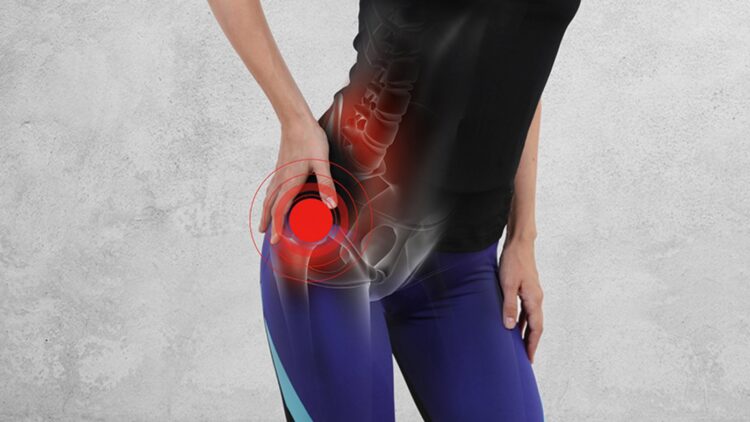Hip pain is a common complaint amongst people of all ages and activity levels, from sedentary individuals to competitive athletes. Whether caused by overuse, underuse or underlying medical conditions, hip pain can significantly impact quality of life and daily function.
Targeted stretching exercises can be a powerful tool for managing hip pain, improving flexibility and promoting overall hip joint health. When incorporated into a regular routine, stretching can help alleviate discomfort, prevent future injuries and enhance physical performance.
Common Causes of Hip Pain

1. Tight Muscles
Tightness in the muscles surrounding the hip joint, including the hip flexors, hamstrings, quadriceps, and gluteal muscles, can contribute to hip pain and dysfunction. Prolonged sitting, lack of stretching, and overuse can all generate muscular tension and imbalances which put excess strain on the hip joint.
Targeted stretching exercises can help lengthen and relax these tight muscles, reducing pain and improving overall hip mobility.
2. Weak Core and Hip Muscles
Weakness in the core and hip stabilizer muscles, such as the gluteus medius and minimus, can lead to poor hip alignment and increased stress on the joint. When these muscles are not strong enough to support proper hip mechanics it can lead to pain, instability, and compensatory movement patterns.
Incorporating stretching exercises that target the core and hip muscles can help improve strength, stability, and overall hip function.
3. Overuse Injuries

Repetitive stress and high-impact activities can lead to overuse injuries in the hip, such as bursitis, tendonitis, or labral tears. These conditions often result from a combination of poor technique, inadequate rest and recovery, and underlying muscle imbalances.
Stretching exercises can help prevent overuse injuries by promoting balanced muscle length and flexibility, reducing joint stress, and enhancing overall hip resilience.
4. Arthritis
Osteoarthritis and other forms of arthritis can cause hip pain, stiffness, and decreased range of motion. As the protective cartilage in the hip joint wears down over time this can lead to inflammation, discomfort, and difficulty with daily activities.
While stretching cannot reverse the structural changes associated with arthritis it can help manage symptoms, maintain joint mobility and improve overall function.
5. Referred Pain
In some cases, hip pain may actually originate from other areas of the body, such as the lower back, sacroiliac joint or knee. This referred pain can be caused by nerve irritation, muscular imbalances, or postural issues.
Stretching exercises that target the muscles and connective tissues throughout the lower body can help alleviate referred hip pain and promote overall alignment and function.
Effective Hip Stretching Exercises

1. Hip Flexor Stretch
The hip flexors, located at the front of the hip, can become tight from prolonged sitting or overuse. To stretch these muscles, kneel on one knee with the other foot in front, then gently shift your weight forward until you feel a stretch at the front of the hip.
Hold for 20-30 seconds, then repeat on the other side. Tools like the CastleFlexx stretching strap can help deepen the stretch and provide support.
2. Hamstring Stretch
Tight hamstrings can contribute to hip pain and alter lower body mechanics. To stretch these muscles, sit on the floor with one leg extended and the other bent, then reach forward toward your toes until you feel a stretch at the back of the thigh.
Hold for 20-30 seconds, then repeat on the other leg. Using a CastleFlexx stretching strap can help you safely extend your reach and maintain proper alignment.
3. Piriformis Stretch
The piriformis muscle, located deep in the buttocks, can become tight and irritated, creating hip pain and sciatica-like symptoms. To stretch this muscle, lie on your back with both knees bent, then cross one ankle over the opposite knee.
Gently pull the crossed knee toward your chest until you feel a stretch in the buttocks. Hold for 20-30 seconds, then repeat on the other side.
4. Adductor Stretch
The adductor muscles, located along the inner thigh, can become tight and contribute to hip pain and groin strain. To stretch these muscles, sit on the floor with your legs spread wide, then gently lean forward until you feel a stretch along the inner thighs.
Hold for 20-30 seconds, then repeat. Using a CastleFlexx stretching strap can help you safely maintain your stretch and prevent overstretching.
5. Quadriceps Stretch
Tight quadriceps muscles can pull on the hip joint and alter lower body alignment. To stretch these muscles, stand near a wall or chair for support, then bend one knee and grasp your ankle behind you.
Gently pull your heel toward your buttocks until you feel a stretch at the front of the thigh. Hold for 20-30 seconds, then repeat on the other leg.
Tips for Effective Hip Stretching

- Warm-up first ─ Always perform a light warm-up before stretching to increase blood flow, raise muscle temperature and prepare the body for activity. This can include gentle walking, cycling or dynamic stretching exercises.
- Hold Stretches for 20-30 Seconds ─ To effectively lengthen muscles and improve flexibility, aim to hold each stretch for 20-30 seconds, breathing deeply and relaxing into the stretch. Avoid bouncing or forcing the stretch beyond a comfortable range.
- Use proper form and alignment ─ Maintain proper body alignment and technique during stretches to maximize effectiveness and prevent injury. Keep the spine neutral, the pelvis level and the stretching leg straight or slightly bent as needed.
- Incorporate tools for support and depth ─ Using tools like the CastleFlexx stretching strap can help you safely deepen your stretches, maintain proper form and target specific muscle groups. These tools can be especially helpful for those with limited flexibility or balance issues.
- Stretch regularly ─ To see lasting improvements in flexibility and hip pain, aim to stretch at least 3-5 times per week. Consistency is key for maintaining muscle length, preventing tightness, and promoting overall hip health.
- Listen to your body ─ Stretching should never be painful or cause sharp, shooting sensations. Listen to your body and respect your individual limits, modifying or backing off from stretches as needed.
If pain persists or worsens, consult with a healthcare provider or physical therapist.
Conclusion
Hip pain can be a frustrating and debilitating condition, impacting daily activities and overall quality of life. By incorporating targeted stretching exercises into a regular routine, individuals can effectively manage hip pain, improve flexibility, and promote optimal hip function.
Stretching exercises that target the hip flexors, hamstrings, piriformis, adductors, and quadriceps can help alleviate tightness, reduce joint stress, and prevent future injuries. Using tools like the CastleFlexx stretching strap can enhance the effectiveness and safety of hip stretches, providing support, depth, and targeted muscle engagement.
By combining consistent stretching with proper warm-up, technique, and body awareness, individuals can take proactive steps toward managing hip pain and improving overall lower body function. With patience, persistence, and a commitment to regular stretching, individuals can find lasting relief from hip pain and enjoy improved mobility, flexibility, and overall quality of life.
 Hi Boox Popular Magazine 2024
Hi Boox Popular Magazine 2024



